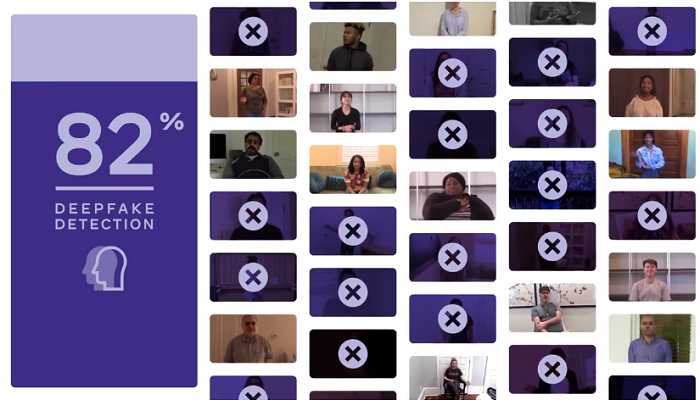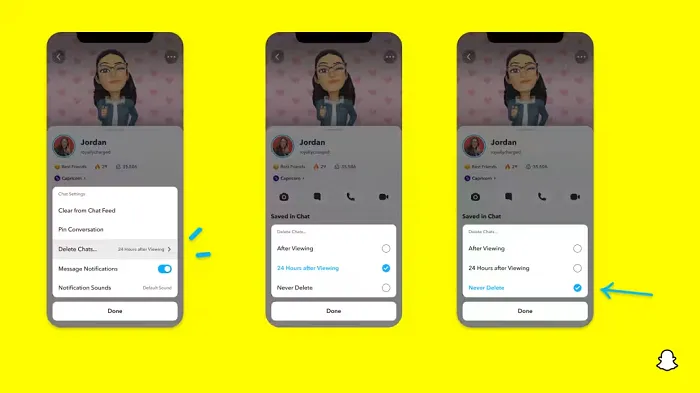SOCIAL
Facebook Shares the Results of its First Deepfake Detection Challenge

With various politically-affiliated groups already using digital platforms to manipulate and influence voters, the rise of deepfakes is a serious concern, and could pose a major threat to democracy as we know it.
That’s why all the major platforms are working to develop systems to detect digitally altered videos, in order to catch them before they can spread. Twitter launched its ‘Manipulated Media’ policy back in February for this purpose, while Facebook has been looking at ways to advance its own detection models. In line with this, back in September, The Social Network issued a challenge to academic teams to come up with better deepfake detection models which could be used to weed out these videos.
And this week, Facebook has shared the results of its first Deepfake Detection Challenge.
As explained by Facebook:
“The DFDC launched last December, and 2,114 participants submitted more than 35,000 models to the competition. Now that the challenge has concluded, we are sharing details on the results and working with the winners to help them release code for the top-performing detection models.”
This is a key point – Facebook, upon working with the winning teams, is looking to share the codebase for each of the winning models, while it’s also planning to open source the datasets used, in order to help advance research into deepfakes more broadly.
So how good were the winning models?

The best performing detection models, from the thousands submitted, saw detection rates above 82%. Which is impressive – but that was based on the training set provided, which the researchers could study and refine specifically, focused on those examples.
In order to determine the true accuracy of these systems, Facebook also tested the models on a ‘black box’ dataset of 10,000 video clips which the participants had not previously seen and had no access to before submitting their code. That altered the final results significantly.
“The highest-performing entrant was a model entered by Selim Seferbekov. It achieved an average precision of 65.18% against the black box data set. Using the public data set, this model had been ranked fourth. Similarly, the other winning models, which were second through fifth when tested against the black box environment, also ranked lower on the public leaderboard. (They were 37th, 6th, 10th and 17th, respectively.)”
As you can see, the results changed a lot when they were applied to videos that the researchers could not train for specifically. That likely shows that there’s still a long way to go in establishing a truly accurate deepfake detection system – though a 65% detection rate is still significant, and would likely help to flag many potential concerns within the posting process.
Ideally, however, Facebook can get this number higher, and develop a better system for determining digitally altered videos before they’re shared. Because as we’ve seen, once a video is uploaded online, the fact that it’s determined to be fake or edited at a later stage is often too late to stop the damage being caused.
Already, within this US Presidential Election cycle, we’ve seen several examples of videos being edited or changed in order to emphasize certain elements. There was the controversial Nancy Pelosi video, in which Pelosi appeared to be slurring her words, the Michael Bloomberg video where he pressed other candidates on their business credentials during a debate, and the Joe Biden clip which had been edited to show Biden saying that people should vote for Donald Trump.
These videos were not advanced deepfakes, they all used fairly basic editing techniques. But each of them sparked significant debate, despite them being heavily edited, and proven to be so. Even when they were revealed to be edited, the debates carried on. You can only imagine the damage that a convincing enough deepfake could do within that same process.
And we are indeed likely to find out just how much damage deepfakes can do. As the 2020 US Election race heats up, it seems increasingly likely that, at some stage, a deepfake video of some kind will come into play.
How will that change the race? How will it alter voter behavior? Can digital platforms detect and eliminate such before it takes hold?
It could just be that in the wake of the election, a deepfake video might be the central focus, much like Cambridge Analytica became the target after 2016. Facebook’s working to avoid that outcome, and it could end up bring a crucial effort.
You can read more about Facebook’s Deepfake Detection Challenge here.
SOCIAL
Snapchat Explores New Messaging Retention Feature: A Game-Changer or Risky Move?

In a recent announcement, Snapchat revealed a groundbreaking update that challenges its traditional design ethos. The platform is experimenting with an option that allows users to defy the 24-hour auto-delete rule, a feature synonymous with Snapchat’s ephemeral messaging model.
The proposed change aims to introduce a “Never delete” option in messaging retention settings, aligning Snapchat more closely with conventional messaging apps. While this move may blur Snapchat’s distinctive selling point, Snap appears convinced of its necessity.
According to Snap, the decision stems from user feedback and a commitment to innovation based on user needs. The company aims to provide greater flexibility and control over conversations, catering to the preferences of its community.
Currently undergoing trials in select markets, the new feature empowers users to adjust retention settings on a conversation-by-conversation basis. Flexibility remains paramount, with participants able to modify settings within chats and receive in-chat notifications to ensure transparency.
Snapchat underscores that the default auto-delete feature will persist, reinforcing its design philosophy centered on ephemerality. However, with the app gaining traction as a primary messaging platform, the option offers users a means to preserve longer chat histories.
The update marks a pivotal moment for Snapchat, renowned for its disappearing message premise, especially popular among younger demographics. Retaining this focus has been pivotal to Snapchat’s identity, but the shift suggests a broader strategy aimed at diversifying its user base.
This strategy may appeal particularly to older demographics, potentially extending Snapchat’s relevance as users age. By emulating features of conventional messaging platforms, Snapchat seeks to enhance its appeal and broaden its reach.
Yet, the introduction of message retention poses questions about Snapchat’s uniqueness. While addressing user demands, the risk of diluting Snapchat’s distinctiveness looms large.
As Snapchat ventures into uncharted territory, the outcome of this experiment remains uncertain. Will message retention propel Snapchat to new heights, or will it compromise the platform’s uniqueness?
Only time will tell.
SOCIAL
Catering to specific audience boosts your business, says accountant turned coach

While it is tempting to try to appeal to a broad audience, the founder of alcohol-free coaching service Just the Tonic, Sandra Parker, believes the best thing you can do for your business is focus on your niche. Here’s how she did just that.
When running a business, reaching out to as many clients as possible can be tempting. But it also risks making your marketing “too generic,” warns Sandra Parker, the founder of Just The Tonic Coaching.
“From the very start of my business, I knew exactly who I could help and who I couldn’t,” Parker told My Biggest Lessons.
Parker struggled with alcohol dependence as a young professional. Today, her business targets high-achieving individuals who face challenges similar to those she had early in her career.
“I understand their frustrations, I understand their fears, and I understand their coping mechanisms and the stories they’re telling themselves,” Parker said. “Because of that, I’m able to market very effectively, to speak in a language that they understand, and am able to reach them.”Â
“I believe that it’s really important that you know exactly who your customer or your client is, and you target them, and you resist the temptation to make your marketing too generic to try and reach everyone,” she explained.
“If you speak specifically to your target clients, you will reach them, and I believe that’s the way that you’re going to be more successful.
Watch the video for more of Sandra Parker’s biggest lessons.
SOCIAL
Instagram Tests Live-Stream Games to Enhance Engagement

Instagram’s testing out some new options to help spice up your live-streams in the app, with some live broadcasters now able to select a game that they can play with viewers in-stream.
As you can see in these example screens, posted by Ahmed Ghanem, some creators now have the option to play either “This or That”, a question and answer prompt that you can share with your viewers, or “Trivia”, to generate more engagement within your IG live-streams.
That could be a simple way to spark more conversation and interaction, which could then lead into further engagement opportunities from your live audience.
Meta’s been exploring more ways to make live-streaming a bigger consideration for IG creators, with a view to live-streams potentially catching on with more users.
That includes the gradual expansion of its “Stars” live-stream donation program, giving more creators in more regions a means to accept donations from live-stream viewers, while back in December, Instagram also added some new options to make it easier to go live using third-party tools via desktop PCs.
Live streaming has been a major shift in China, where shopping live-streams, in particular, have led to massive opportunities for streaming platforms. They haven’t caught on in the same way in Western regions, but as TikTok and YouTube look to push live-stream adoption, there is still a chance that they will become a much bigger element in future.
Which is why IG is also trying to stay in touch, and add more ways for its creators to engage via streams. Live-stream games is another element within this, which could make this a better community-building, and potentially sales-driving option.
We’ve asked Instagram for more information on this test, and we’ll update this post if/when we hear back.
-
SEARCHENGINES6 days ago
Daily Search Forum Recap: April 19, 2024
-

 WORDPRESS7 days ago
WORDPRESS7 days agoHow to Make $5000 of Passive Income Every Month in WordPress
-

 WORDPRESS6 days ago
WORDPRESS6 days ago13 Best HubSpot Alternatives for 2024 (Free + Paid)
-

 MARKETING6 days ago
MARKETING6 days agoBattling for Attention in the 2024 Election Year Media Frenzy
-

 WORDPRESS6 days ago
WORDPRESS6 days ago7 Best WooCommerce Points and Rewards Plugins (Free & Paid)
-

 AFFILIATE MARKETING7 days ago
AFFILIATE MARKETING7 days agoAI Will Transform the Workplace. Here’s How HR Can Prepare for It.
-

 MARKETING7 days ago
MARKETING7 days agoTinuiti Marketing Analytics Recognized by Forrester
-

 SEO6 days ago
SEO6 days agoGoogle Answers Whether Having Two Sites Affects Rankings



